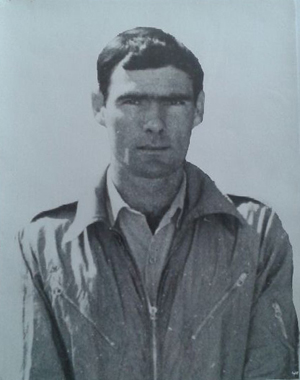|
3rd Battalion Royal Australian Regiment
Your FaithfullyJapan - Korea - Malaya - Borneo - Vietnam - East Timor - Solomons - Iraq - Afghanistan |

Killed in Action
whilst in direct support of the
3rd Battalion RAR
in
Vietnam 1971
|
* Return to 3rd Battalion Roll of Honour
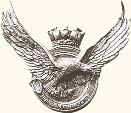 |
|
| Pilot Officer Ronald William Betts 9 Squadron RAAF Australian War Memorial 5th June 2021 |
|
| Download: Pilot Officer Ronald William Betts. The Story of his Life. | |
Pilot Officer Ronald “Bettsy” Betts |
|
O118325 Pilot Officer Ronald William Betts was killed in action whilst serving in Vietnam on the 20th of March 1971 at the age of 24. He was the first RAAF pilot killed in Vietnam. Ronald William Betts was born in Launceston, Tasmania, on the 1st March 1947 to Mr Norman Lindsay “Mannie” Betts and Mrs Jean Betts, brother to Judith, Margaret and Susan. It was very evident early in life that Ronald only ever wanted to fly aeroplanes. In 1958, the family moved to Hobart where Ron’s interests in flying continued. A report from 1961 indicates that Ron, along with several school friends built a small back yard rocket which flew a considerable distance but crashed into a large woolshed of a local company with an article in The Mercury showing a gaping hole in the roof of the property. |
|
Ron attended Moonah SDA School in Hobart and later Avondale College, Cooranbong, N.S.W. He completed courses that were necessary to achieve entry into civil aviation. After completing his studies in 1966 Ron hitch hiked with David Adderton, a close friend, to Cairns and then flew to Papua New Guinea (PNG). His friend’s uncle was Director of Public Health in PNG and assisted Ron to obtain work as a pay clerk in Government offices administration. Ron’s father Mannie Betts had been a radio operator with the RAAF in PNG during WW11. During Ron’s time in PNG he spent much of his spare funds on learning to fly and eventually achieved his private pilot’s licence, with licensing still under Australian Government regulation. In 1968, aged 21, with his PPL and several glowing references from his employer Mr L. R. Healey, Staff Inspector, the Salaries OIC and the Director of Public Health in PNG and a few hours in his log, Ron applied to the RAAF to become a trainee pilot. He was accepted and undertook his basic training at Point Cook on Winjeel aircraft. |
|
Not everything went smoothly at first, however his quiet personality and his keen sense of duty along with his keen interest in aircraft assisted Ron to develop his skills and good qualities needed to succeed and become a valuable member of the RAAF. Ron then moved to RAAF Pearce in W.A. to complete his training on the Vampire where he graduated in June 1969. |
|
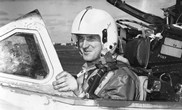 |
|
After Pearce, in September 1969 Ronald was posted to a fighter squadron where he found the skills required to be challenging and he was sent to 5 Squadron (Sqn) at Fairbairn to train in Iroquois. Aivars Vilcins, who was on the same pilot’s course as Ron, and who had been posted to Canberra from Pearce, says he can remember Ron coming to 5 Sqn sometime after they had left Pearce and they flew together a few times. |
|
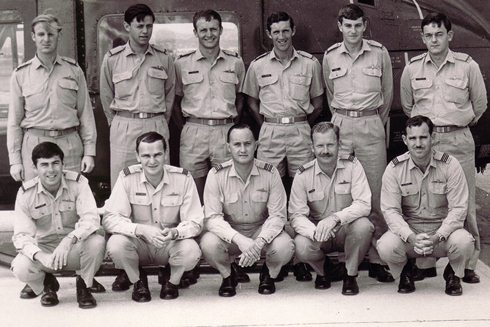 Back Row: Ron Betts, Mark Julienne, John Buchanan, Graeme Chalmers, Peter Drury, Peter Armstrong. Front Row: John Millhouse, John Dahlitz, Peter Mahood, John Dunn, John Pollock. Iroquois No 10 Conversion Course RAAF Fairbairn ACT December 1969 |
|
Peter Armstrong, who was on the pilot’s course after Ron says: “Due to the way the course was organised, we ended up on the same 15-week helicopter conversion course.” Ron’s preferences at the time of his deployment were listed as being fighters, bombers, or Hercules E model. Following completion Flg Officer Ronald Betts was posted to 9th Squadron on 7th July 1970 in Vung Tau, Vietnam flying there on the 23rd July 1970. Graeme Chalmers was also on the Iroquois conversion course and was posted to 9 Sqn at the same time as Ron said: “Ron and I became great mates whilst on the course and while in Vung Tau. We went to Penang in Malaysia together for a memorable R and C (Rest and Convalescence) breather”. On the morning of the 20 March 1971, 9 Sqn was required to carry out a “Sniffer” flight which proved to be a routine task with few readings. The “Sniffer” was an electronic personnel detection device, developed by General Electric for the US Army Chemical Corps and was mounted in the helicopters. It detected effluents unique to humans such as those found in urine and sweat. On the first sortie, Flg Off David Freeman and Plt Off Ron Betts were the pilot/co-pilot of Bushranger 71 and Flg Off Stuart Bryce went along for the ride. Early in the afternoon of 20 March, after the completion of the Sniffer flight, two Bushranger aircraft, Bushranger 71 and Bushranger 72, (with B73 and B74 in reserve) were called to support 8 Platoon C Coy, 3RAR, which had made contact with members of NVA D445 a little north of Xuan Moc, Phuoc Tuy. A patrol was engaged by enemy in bunkers, with small arms RPG and hand grenades mortally wounding the Platoon Commander, Second Lieutenant David Paterson, and very seriously wounding forward scout Pte Alan Gould. The remainder of the patrol was forced to withdraw with another seriously wounded soldier Pte Martin S Macanas and called in the Light Fire Team to assist. On arrival the aircraft could not engage effectively because the patrol was unable to mark the target having run out of smoke grenades and were in very close proximity to the enemy. A second half of the same platoon was pinned down a short distance from the main contact which interfered the aircraft approach because they were directly below the flight path of the helicopters and within meters of the contact area. The enemy were entrenched close to a deep gully escarpment on the northern side and only about 30 meters from the Australian platoon's position which meant the aircraft had to fly low and close to the enemy’s position. Such was the terrain that, after each pass, the Bushranger had to break right to escape. Whilst that happened, it was covered by the other Bushranger. On one pass with Ron flying, the aircraft broke right, the turn being so tight that the Iroquois experienced retreating blade stall. |
|
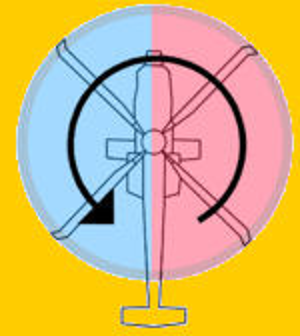 |
Retreating blade stall is a hazardous flight condition in helicopters where the rotor blade rotating away from the direction of flight stalls. Retreating blade stall is the primary limiting factor of a helicopter's airspeed and the reason that helicopters can only fly slightly faster than 200 knots. |
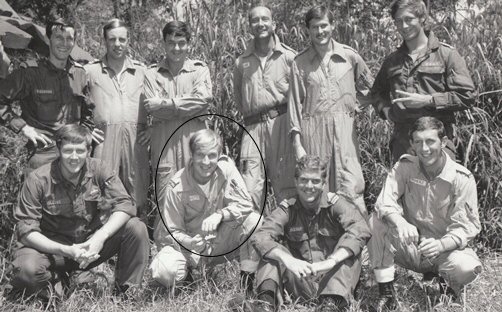 Back Row L-R: Dave Freedman, Chris Peters, Peter Armstrong, Stan Clarke, Phil Smith, Mick Castles. Front L-R: Iviars Vilcins, Ron Betts, Ron Bishop, Graeme Chalmers. |
|
B71 flipped, reversed its turn and lost altitude, heading straight for the escarpment. Dave Freedman recovered the aircraft which hobbled away but was forced to fly practically over the enemy. The aircraft returned safely to Nui Dat to rearm and refuel. Ron was keen to get back to the battle site to get his hours up. B71 subsequently returned to the battle, this time without Stuart Bryce. B 71 hovered over the ground patrol endeavouring to drop resupply smoke grenades but was hit some 47 times by .50 calibre heavy machine gun fire just 50 feet above the patrol. B72 was not able to provide cover because of the unknown position of the friendlies. Ron was hit by one or more bullets at close range and mortally wounded. The aircraft was forced to land at Fire Support Patrol Base Beth, where Ron Betts died; the first RAAF pilot to be killed in action in Vietnam. Ron was medivaced to the giant US 24th 24 Evac Hospital EVAC Hospital at Long Binh.but was dead on arrival. The pilot of the “Dustoff” aircraft that transported Ron to the hospital was his mate Peter Armstrong. Peter Armstrong remembers Ron as immensely popular and well-liked bloke and in Vietnam, “his piano playing after a few beers was enjoyed by many. His death really shook 9 Sqn. I was the dustoff (medivac) pilot that day and saw the action in which he was killed. I picked him up and took him to the hospital which, unfortunately, was in vain. I will never forget that day.” Ronald flew as best as can be ascertained 194 flights in Vietnam, around 536.45 hours and just on 1500 sorties. He had qualified as Captain and spent 143 hours in that role. In March 1971 Ron had been made a “Unit Test Pilot”. During March 1971, 6 Iroquois were damaged by enemy fire and 4 required Chinook lift recovery. “When the powers that be finally decided to give the Vietnam vets the so-called welcome home march in 1987, they had Australian flags with the names of all the ‘Killed in Action’ men engraved (one for each). I carried the one with Ron’s name on it and was proud to do so. I hope the flag eventually reached his family, as it was meant to.” Ron’s body was repatriated to Australia and buried at the Carr Villa Memorial Park, General Cemetery, in Launceston, Tasmania. |
|
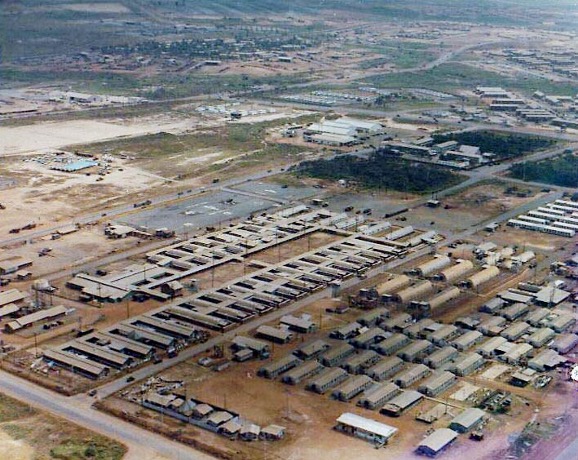 |
|
In July or August 1971 shortly after he had returned to Australia, Graeme Chalmers flew down to Ron Betts hometown of Launceston to visit Ron’s grave. He says he’s sure he met one or two of Ron’s sisters but can’t be sure as it was 37 years ago. “My memories of “Bettsy” have always been with me” he said. “After many years of never marching on Anzac Days etc, I changed my mind because I believed it was right to march for Ron and the other Australians killed in the Vietnam War in order to honour them.” |
|
“Many years after Ron’s death I flew on the RAAF/USAF Exchange Program and spent 2½ years flying big choppers in America in the Combat Search and Rescue role. The motto of my then Unit depicted an angel with wings about a globe and the wording was “THAT OTHERS MAY LIVE”. Cemetery or memorial details: Carr Villa General Cemetery, Launceston, Tasmania (Y14 Number 60.0) |
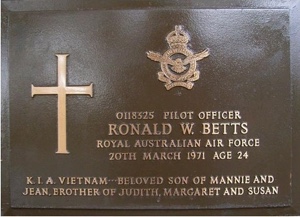 |
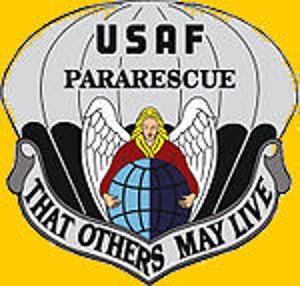 USAF Pararescue That Others May Live |
Freddo Freedman, Ron and the crew in A2-383 on the day Ron was shot, were unknowingly following the tenet of that motto and displayed the greatest of Australian military tradition, to be prepared to give one’s life for others (in this case the Australian soldiers who were killed and those that were still alive and fighting the enemy for their very lives). Ron made the ultimate sacrifice.” |
In May 2009, more than 33 years following the end of the Vietnam War, the Lindisfarne (Hobart) RSL opened the Tasmanian Vietnam Veterans’ Memorial at Anzac Park on the banks of the Derwent River, to pay tribute to the 16 Tasmanian men who were killed during the conflict. The memorial comprises a central stone and plaque, surrounded by 16 individual plaques, one for each of the men. |
|
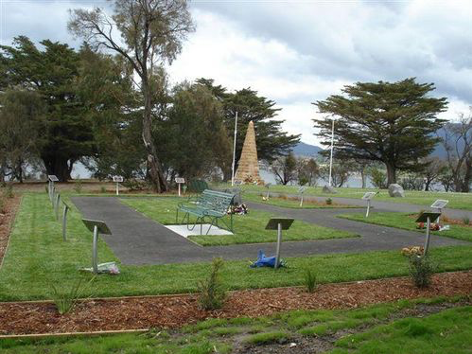 |
|
Ron’s sister, Judith Stanton, said the memorial unveiling was a dream come true. The memorial gave her somewhere to go to remember his life. “It is beautiful, a real tribute to all the men who lost their lives in Vietnam,” she said. Her brother, when he was younger, always dreamed of flying for his country. “It was his father’s dream as well but, because of bad health, he couldn’t continue, so Ronald lived it for him,” she said “It is something that he wanted to do. It was his dream and he enlisted to serve his country." I feel very proud of him. “This new memorial will now give the dignity that these 16 young Tasmanians who gave their lives in the course of duty deserve. “We give thanks for a belated but fitting memorial. The aircraft in which they were flying, Iroquois A2-383, started life as a D model and initially 9 Sqn Gunship flew with the US Army but was modified to H model specs then sold to the RAAF and delivered to 9 Sqn on the 6th February 1968 and converted to a Bushranger. It flew its first sortie with the RAAF shortly after on the 14th February. After Ron’s tragic death it was sent back to Amberley (Nov 1971) where it was repaired then sent to PNG where it collided with A2-915. Once again, it was sent back to Amberley for repair and eventually written off in March 1974. Peter Haran has written a book called Shockwave which is the graphic story of the pilots and crews of Australia's fleet of Iroquois helicopters during the Vietnam War, the Dust-offs and the Bushrangers, their triumphs and losses, and the legacy of that experience that Shockwave book some still carry today. |
|
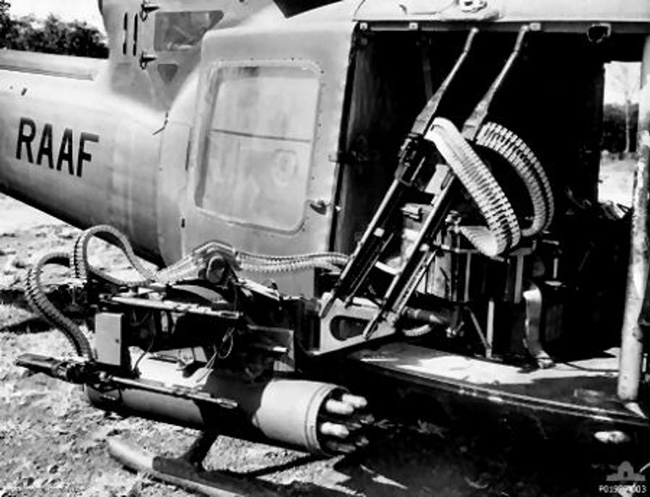 |
|
There is extensive coverage of the action in which Ron was killed in Peter Haran’s book, (pages 54-70). The book is no longer available. |
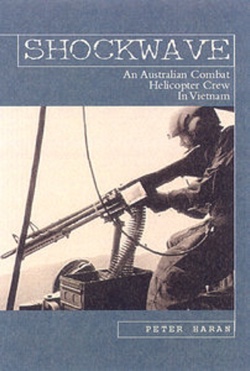 |
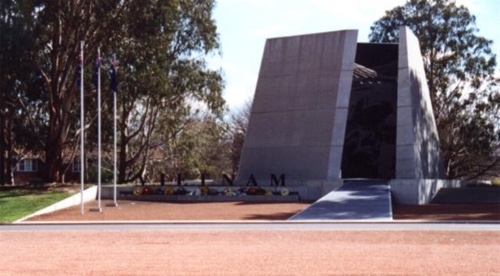 Australian Vietnam Forces National Memorial |
|
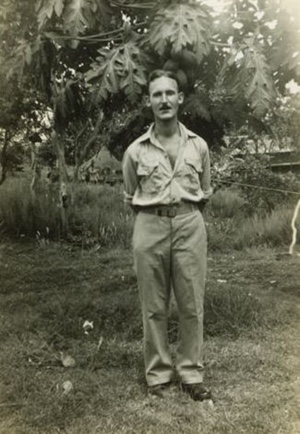 |
During the second world war, Ron’s father, Norman Lindsay “Mannie” Betts served with the RAAF in PNG as a radio/Morse code operator. Norman Lindsay (Mannie) He was born in 1915 in Oaks, a small settlement in northern Tasmania, not far from Launceston and enlisted in November 1941 and was discharged in December 1945 with the rank of Cpl. |
After the war, Norm returned to Tasmania. He was a keen jazz muso and later played at The Launceston Hotel and Wrest Point in Hobart. He had Launceston Hotel his own gig for many years and while self-taught, his sense of rhythm and beat was greatly admired. It seems the RAAF is in the blood of the Betts family; Manny’s grandson trained at ADFA to join the RAAF. |
|
 A-2 BELL UH-1 IROQUOIS. |
|
No 9 Squadron, under Sqn Ldr R A Scott, received the first aircraft on October 29 1962. These aircraft were serialised A2-384 to A2-391. The Iroquois began life as a troop support aircraft for the Army and this was to become a major role for No 9 Squadron. In December 1962 a second batch of eight UH-1Bs were ordered and delivered twelve months later as A2-714 to A2-721. In May 1964, No 5 Squadron was formed at Fairbairn with four aircraft and deployed to Malaysia to provide support during the confrontation period with Indonesia. A third batch was delivered in late 1964, A2-1018 to A2-1025. These were fitted with the more powerful Lycoming T53-L-11 engine which produced 1,100shp engine replacing the previous T53-L-9 engine. In April 1966, No 5 Squadron reformed at Fairbairn, and No 9 Squadron then deployed with the third batch of aircraft to Vietnam. Arriving at Vung Tau in June, 9 Squadron began immediate operations in support of Australian ground forces. Army roles included airlift and resupply, aeromedical "dustoff" evacuation and insertion and extraction of SAS troops. Two of an enlarged version of the Iroquois, the UH-1D, were delivered over 1966-67 to Vung Tau as replacements. The larger cabin of the UH-1D ("Delta") enabled carriage of an additional four passengers. A further six were delivered to 5 Squadron (A2-505 to A2-510) but the UH-1D was soon superseded by the UH-1H, which had the same enlarged fuselage powered a more powerful 1,300shp T53-L-13 engine. RAAF Deltas were later retrofitted to this standard. Sixteen UH-1Hs were ordered to replace the UH-1B's in 9 Squadron and were delivered direct from the US Army to Vung Tau. These were A2-376 to A2-383 and were received in February 1968, followed in July by A2-766 to A2-773. This enabled the withdrawal of the Bravos from Vietnam to Australia, where these aircraft were able to reinforce SAR flights at Darwin, Williamtown, Pearce and Butterworth, and the type was also flown by the Aircraft Research and Development Unit. As 5 Squadron was the training unit for 9 Squadron, the SAR flights and the RAN, in addition to providing Army support throughout Australia, a further seven UH-1Hs were ordered for 1970 delivery: A2-484 to A2-490. During 1969 gunship modifications were carried out on some aircraft by 9 Squadron. These aircraft could be converted from the "Slick" transport configuration to "Bushranger" gunships. Meanwhile 9 Squadron received two more Hotel models: A2-149 and A2-110. With the loss on operations in October 1969 of A2-381 and A2-769 (both wrecks were later completely destroyed by SAS demolition teams), two replacements were ordered from the US Army. A2-703 and A2-723 were delivered in July 1970. With the subsequent loss of A2-768, A2-767 and A2-723, two further replacements were received in mid 1971: A2-455 and A2-915. No 9 Squadron returned from Vietnam to Amberley in December 1971. Five more UH-1Hs were delivered in 1973 and these were delivered and flown by 35 Squadron at Townsville. These aircraft were A2-278/279/295/296 and 310. The RAN also operated the Iroquois: three UH-1B and four UH-1C models, the first batch of which were delivered in 1964. A further four UH-1Cs, were delivered over 1965-66. In Australia the RAN Iroquois served with HC723 Squadron at HMAS Albatross on utility, training and search/rescue tasks. After being withdrawn from service in 1987 the surviving aircraft re-entered service due to the withdrawal of the Wessex. The final three ageing UH-1s were then finally paid off from RAN service on May 31 1989. |
|
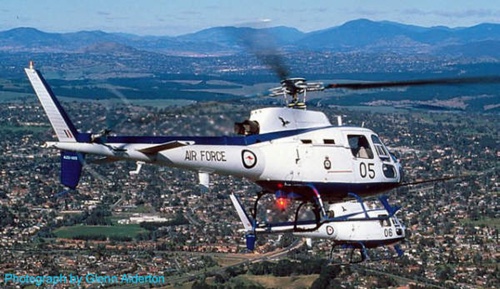 |
|
A major though little-known role for Iroquois detachments has been survey operations. Much work has been carried out over the past quarter century in mapping the remote areas RAAF Squirrel of Papua New Guinea and Indonesia. A different peacetime task has been providing support to United Nations peace keeping forces in the Middle East. All-white RAAF UH-1Hs with UN markings served with the United Nations Emergency Force (UNEF) in Egypt at Ismalia (from 1976 to 1979) and with the UN Multi-National Force and Observers (MFO) in Sinai (1982-1985). In December 1984 the Bravos were replaced in service by the Squirrel in the training and SAR roles. The last UH-1B in service was A2-384, flown by No 5 Squadron until March 1985. However, the last RAAF Bravo Flight was on May 21 1985 when A2-1019, earmarked for display at the Australian War Memorial, staged a ceremonial flight over Canberra. Surviving aircraft were stored and offered for disposal in December 1985. With the loss of the RAAF rotary wing capability, the remaining 25 Iroquois were transferred to the Army's 171 Squadron and Aviation School at Oakey and 5 Aviation Regiment at Townsville. Rarely has an aircraft type seen such diverse operation with Australian forces and given such long and sterling service as BELL UH-1. |
|
Aircrew 9 SQN Nui Dat 1970 - 1971 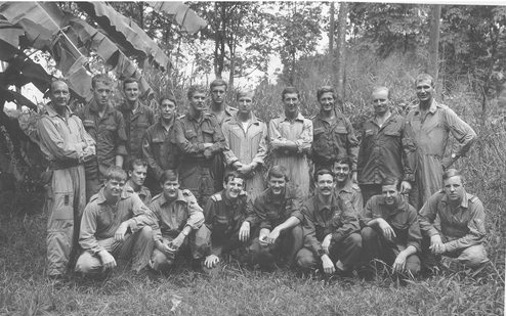 Back Row: Ron Betts, Mark Julienne, John Buchanan, Graeme Chalmers, Peter Drury, Peter Armstrong. Front Row: John Millhouse, John Dahlitz, Peter Mahood, John Dunn, John Pollock. Iroquois No 10 Conversion Course RAAF Fairbairn ACT December 1969 |
|
UNIT HISTORY SHEET In the early afternoon, the bushrangers were called to YS648786 to support 2 (8) platoon C Coy 3 RAR, who had their platoon commander and signaller wounded and separated from main column. A great amount of confusion therefore existed which was corresponded by the main column being out of smoke markers. Bushranger 71 was endeavouring a smoke resupply when the A/C was hit by heavy ground fir. The co-pilot, Fls Off R. W. Betts (0118325) was wounded. Bushranger 72 was unable to suppress because of the unknown position of friendlies. Bushranger 73 and 74 were called forward and 71 landed at FSB Beth. Flt Off Betts was medevac’d to REDEARTH and then to 24th EVAC, Long Binh but subsequently died from his wounds. In addition Dustoff 1, Plt Off P. J. Armstrong (0224936) took 3 Aust (1KIA 2 WIA) from YS6478 to VAMPIRE. The Dustoff captain commended the work of his crewmen A111550 LAC Bloxsom A.C., his gunner A225052 LAC Munnon P. R., and his Army medic. - |
|
Canberra ACT 2011
| Ronald Betts See also: Australia and the Vietnam War |
| Radschool Association Magazine - Vol 37 |
Photographs from the 40th Anniversary 3rd Battalion RAR Canberra ACT reunion Remembrance Service on the
16th October 2011 |
Audio file Contact 20th March, 1971
Audio File: Authentic audio recording of the radio communications that occurred between the various participants
on the ground and in the air during the 20th March 1971 contact. The main individual heard clearly is Col Peter Scott. CO 3 RAR 1971 located in the helicopter above the contact. Ground communications are difficult to hear or not audible.
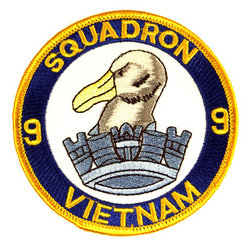

| Service number: O118325 Rank: Pilot Officer Unit: 9 Squadron Service: Royal Australian Air Force Conflict: Vietnam, 1962-1975 Date of death: 20 March 1971 Place of death: Vietnam (air operations) Cause of death: Gunshot wounds Cemetery or memorial details: Carr Villa General Cemetery, Launceston, Tasmania (Y14 Number 60.0) Source: AWM153 Roll of Honour cards, Vietnam |
* Return to 3rd Battalion Roll of Honour
![]()

LAC Alan Clarence Bloxsom
9 Squadron RAAF
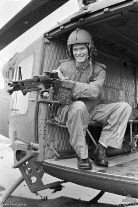
![]()
1 Platoon 2 RAR (Under operational Control by 3 RAR) engaged the enemy in a very large and well fortified bunker system located on the Song Rai. Withdrawing from the contact was difficult however wounded were eventually removed with the assistance of reinforcements who defended the position and assisted in the dust off. Alan Bloxsom 28 Years) was the crewman on the dust off helicopter. He receiving gunshot wounds from enemy ground fire whilst the dust off was occurring.
LAC Alan Clarence Bloxsom
Australian Newspaper
1986
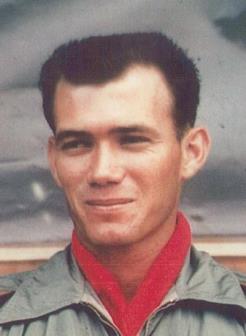
LAC Alan Clarence Bloxsom, Moura, Queensland.
On March 31, 1971, Bloxsom was a crewman on a dust off helicopter called to evacuate troops north of Nui Dat. Be-cause of mortar fire the helicopter was directed to a ground position to pick up causalities. Because of poor visibility he overshot the friendly position and came to hover 3m above the trees over a smoke marker fired by the enemy. Bloxsom was hit by enemy fire which peppered the helicopter and died in hospital.
and
A111550 Leading Aircraftman (LAC) Alan Clarence Bloxsom, of Maryborough, Old, the No 9 Squadron, RAAF, Iroquois helicopter crewman who fought a gun duel with Vietcong (VC) guerrillas during a daring jungle rescue of Australian soldiers in Phuoc Tuy Province on 18 January 1967, is pictured behind his M60 machine gun, sitting in the helicopter on the landing strip at Vung Tau. During an operation in dense jungle country an Australian soldier was wounded, and the patrol called for helicopter support to evacuate him. LAC Bloxsom was the port door gunner, the helicopter was flown by O312600 Flight Lieutenant (Flt Lt) Kevin John Sharpley, of Sunbury, Vic, and the starboard gunner was A39888 Corporal (Cpl) Victor Edward (Vic) Williams, of East Brighton, Vic. LAC Bloxsom engaged the attacking guerrillas with his M60 machine gun and in the action killed two of the enemy. None of the Australians were wounded in the action. LAC Bloxsom was later killed in action on 31 March 1971, when the helicopter in which he was the door gunner was tricked into an ambush. LAC Bloxsom was fatally wounded and the helicopter was badly damaged by enemy fire.

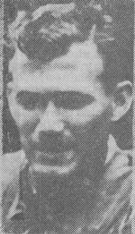

* Return to 3rd Battalion Roll of Honour
Service number: A111550 |
 Flt Lt Everitt Murray Lance 9 Squadron RAAF Remembered by the Australian War Memorial Monday the 7th June 2021. |
|
Downloads |
|
A South African Korean War hero … killed in the Vietnam War “Lofty” Flt Lt Everitt Murray Lance |
|
What! South Africa never took part in the Vietnam War, true – but some South Africans did, and two of them lost their lives. Of the two South Africans sacrificed in this rather misunderstood, baffling and brutal war, it is this one – Everitt Murray Lance (called ‘Lofty’ because of his height) who really stands out for two reasons – he served as a pilot in the South African Air Force prior to fighting in the Vietnam War and he served with the South African Air Force’s 2 Squadron with distinction in the Korean War (yes, for those who did not know, South Africa did take part in the Korean War) So, who is Lofty Lance and how the heck did he land up in both the Korean War and the Vietnam War? Let’s have a look at him as his story is an absolutely fascinating one and we hope to do him a little justice in this article. |
|
| South Africa Air Force and the Korean War | |
Lofty Lance was born in the Aliwal North, Eastern Cape Province, on the Orange River, Central South Africa on 29th April 1928. After his schooling at the Aliwal North High School, his career followed a rather convoluted route, the adventurous life loomed large and he initially joined the Navy and trained on the S.A.T.S General Botha (Cadet 1305) joining the ranks of many ‘Botha Boys’ who would later advance prestigious careers in the military, he then joined his ‘first’ Air Force – The South African Air Force as a fighter pilot.
|
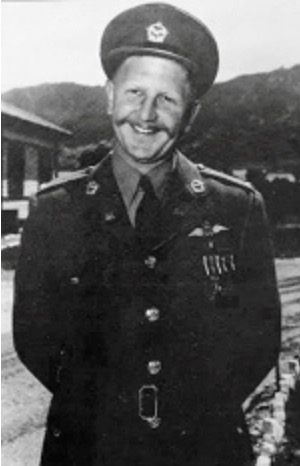 Lofty Lance, SAAF in Korea |
| By 1950 Lofty found himself in his ‘first’ war serving with the SAAF. War broke out in Korea on 25 June 1950 and on 4 August 1950 the South African government announced its intention to place an all-volunteer squadron at the disposal of the United Nations to fight in Korea. On 25 September 1950, SAAF 2 Squadron (including Lofty), known as the Flying Cheetahs, sailed for Japan. On arrival at Yokohama the squadron proceeded to Johnson Air Base near Tokyo where they completed their conversions on F-51D Mustangs supplied by the United States Air Force (USAF). SAAF 2 Squadron served as one of the four squadrons under the command of the USAF 18th Fighter-Bomber Wing and flew their first mission in Korea on 19 November 1950 from K-9 and K-24, Pyong Yang. |
|
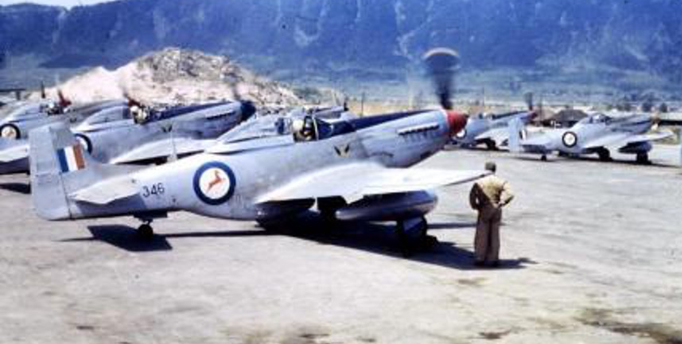 F-51 Mustangs from No. 2 Squadron, South African Air Force (SAAF) conducting run-ups in Korea in 1951. Photo courtesy Mike Pretorius F-51 Mustangs from No. 2 Squadron, South African Air Force (SAAF) conducting run-ups in Korea in 1951. Photo courtesy Mike Pretorius |
|
The SAAF flew with the distinctive Springbok in the centre of the roundel, introduced when 2 Squadron, was sent to Korea. Their role was interdiction against the enemy’s logistic and communication lines, providing protective cover for rescue operations, reconnaissance flights and interception of enemy aircraft. However, the main the SAAF mustangs took part in ‘close air support’ operations in support of ground troops, often sarcastically referred to them as “mud moving” missions, they were highly dangerous as the aircraft has to get right into the battle at very low altitude and speed. It was a ‘baptism of fire’ for the SAAF.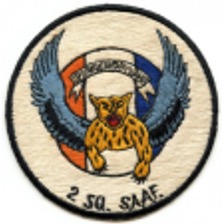 Before moving onto jet propelled Sabre aircraft, the propeller driven Mustang phase of the war saw SAAF pilots on these sorties coming in ‘low and slow’ into the range of enemy ground based anti-aircraft fire which proved highly dangerous and in operations of this kind using the Mustangs, the SAAF lost 74 of its 95 aircraft – nearly the entire squadron’s allocation. |
|
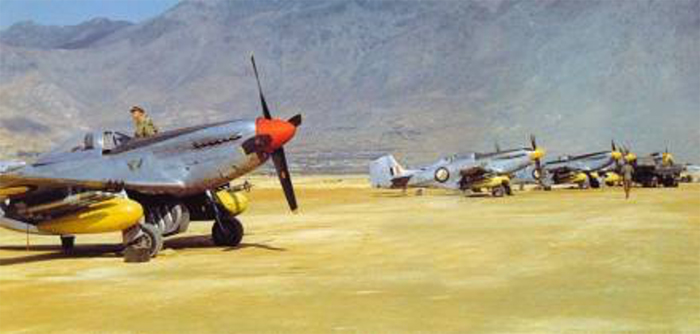 SAAF Mustangs in Korea – the different colour spinners denoted formation rank. |
|
Epitomising the attitude of the SAAF pilots at this time was Lofty Lance who maintained that for all the Mustang’s downsides on the upside it was an excellent aircraft to have a crash in. He would know, during the war he wrote off, not one, but three Mustangs. |
|
|
|
On another one-wheel landing, Lofty Lance’s mustang spun off the runway and ripped through a nearby armoury (which luckily did not explode), tearing off both wings and the rear fuselage. Continuing to slide on for some time was the armoured cocoon containing the cockpit and Loft, once it finally came to a rest and he climbed out completely unscathed. |
|
Royal Canadian Air Force, Royal Air Force and the Royal Australian Air Force. |
|
At the end of the Korean War on 27th July 1953, Lofty Lance decided to advance his career in his ‘second’ Air Force – The Royal Canadian Air Force (RCAF). Wanting to be a fighter pilot he had to start at the beginning and initially landed up flying RCAF Canadair CP-107 Argus (CL-28) maritime reconnaissance aircraft. After a few years of flying the Argus his aspiration to become a fighter pilot led him to become RCAF instructor as a next step. His wanderlust overcame him and he then joined his ‘third’ Air Force – the Royal Air Force (RAF) in 1962. |
|
|
|
As with the Royal Canadian Air Force, when arriving the United Kingdom and joining the RAF Lofty had to advance his career using the same routine, flying instructor first, and he landed up as a flight instructor at RAF Leeming flying RAF Jet Provost trainers. His attitude however remained that of a combat pilot and he was often heard to say, “sod the briefing, let’s fly”. He eventually got a break to become a fighter pilot in the RAF and was posted onto the super-sonic and extremely quick RAF EE Lightings (capable of Mach 2) on which he did two very successful tours. Along the way he married Margaret and had three children, Murray, Graham and daughter Meredath. Margaret was an Australian and Lofty and his family took the decision to move to Australia.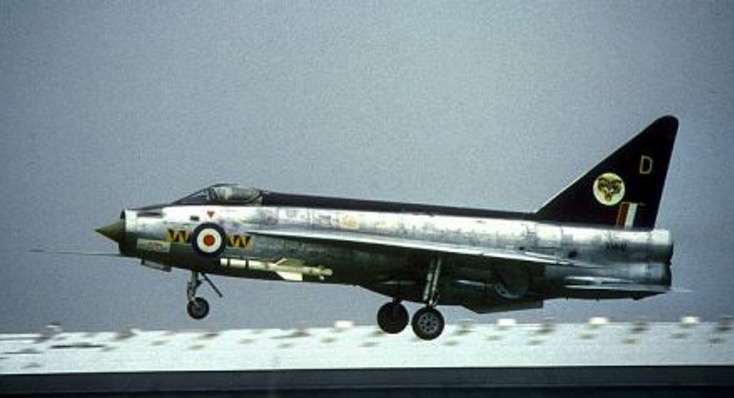 A Royal Air Force English Electric Lightning circa 1962 In Australia he joined his ‘fourth’ and final Air Force, the Royal Australian Air Force (RAAF) and starting from the bottom again on his quest for a fighter pilot role but he found himself instructing and flying RAAF helicopters. Lofty and Margaret moved their residence to 3 Tivey Place, Hughes, Canberra ACT. So how did our hero Lofty find himself in the Vietnam War? |
|
Vietnam War and Australia |
|
No. 9 Squadron Royal Australian Air Force |
|
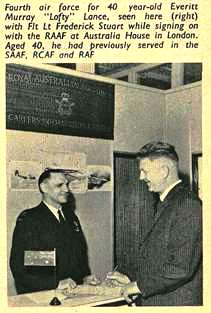 (Photo) FLIGHT International 24th April 1969 Page 693 Flight Global (Aviation History) 1969 |
Australia did not hold back or diminish its support for the USA in the Vietnam War either, it went in all out and sent personnel to Vietnam from literally every arm of service, along with everything from bombers to tanks to artillery – and especially helicopters. As a ‘helicopter’ war the Royal Australian Air Force helicopter (RAAF) squadrons and their pilots were all in supporting both American and Australian ground force operations. By this time Flight Lieutenant ‘Lofty Lance’ was serving as a pilot with No. 9 Squadron RAAF – a helicopter squadron. |
The squadron carried out a number of different types of missions: inserting and extracting Special Air Service patrols, evacuating wounded troops, spraying herbicides and pesticides (now very controversial), dropping leaflets, and flying “olfactory reconnaissance” or “people sniffer” missions (a sophisticated ‘smell’ detector was fitted to the helicopters). The squadron supported every major operation conducted by the Australians, eventually flying 237,424 missions. |
|
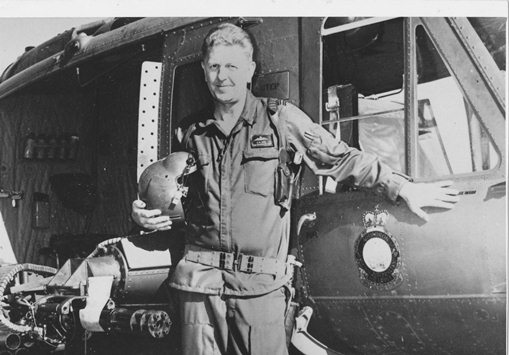 Flight Lieutenant (Lofty) Everitt Murray Lance as part of 9 Squadron RAAF standing next to his Bushranger Huey in Vietnam. |
|
In 1968 the squadron’s size was increased to 16 ‘Huey’ helicopters. Four of the squadron’s Iroquois were subsequently modified into gunships, which carried twin-fixed forward-firing 7.62-millimetre mini-guns and two seven-tube 2.75-inch rocket launchers, in addition to the two door-mounted M60 machine-guns. Known as a ‘Bushranger’ gunship it was able to cover troop-carrying helicopters approaching ‘hot’ landing zones and provide fire support. |
|
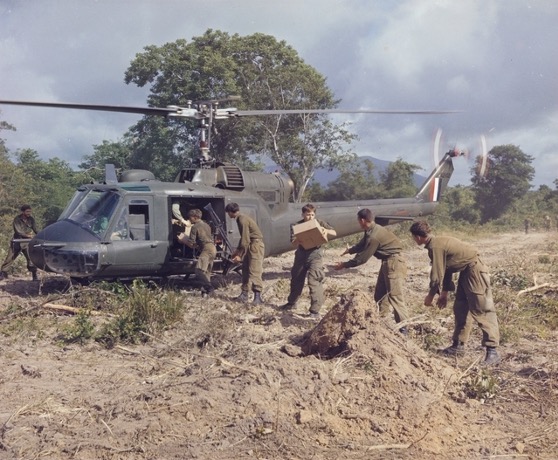 Soldiers from the 7th Battalion, Royal Australian Regiment unloading supplies from a No. 9 Squadron RAAF helicopter during the Vietnam War in 1967. |
|
Rather painfully, as just a few months prior to 9 Squadron’s last mission in Vietnam on the 19th November 1971, Flight Lieutenant ‘Lofty’ Lance would lose his life – 7th June 1971 |
|
| ‘Lofty’ Lance’s Final Flight | |
 |
Now aged 40 years old, Lofty was back in the thick of things flying close support missions again in his RAAF Bushranger Huey. On the 7th June 1971 whilst flying RAAF Iroquois Bushranger’ number A2-723, Lofty Lance was providing gunship, ammunition resupply and casualty evacuation support for Bravo Company of the 3rd Battalion, Royal Australian Regiment and Centurion tanks of the 1st Armoured Regiment, who were involved in an attack on a Vietnamese enemy bunker system in Long Khanh province as part of Operation Overlord. |
During an ammunition resupply, Lofty Lance’s helicopter was hit by enemy fire and crashed into trees killing both him and his gunner, Cpl David John Dubber. Lofty’s co-pilot and one other crew member survived with minor injuries. An initial casevac was attempted but had to be aborted due to intense enemy fire. Under continuous fire from Bushrangers and US Army Gunships, Bravo Company was resupplied with ammunition and the aircrew casualties were eventually evacuated. |
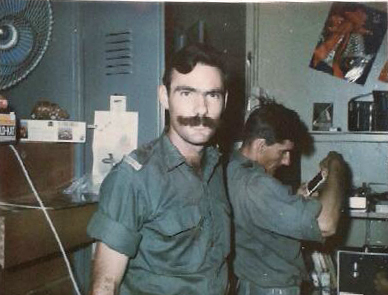 Cpl David Dubber |
|
|
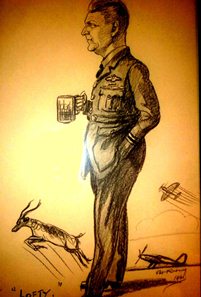 Flt Lt Everitt Murray “Lofty” Lance Caricature from SAAF days |
|
As was the case in many instances experienced during the Vietnam War, the Australians won the day clearing the enemy bunkers and were eventually able to review the crash site and take photos of it, only to have to leave it eventually for the Communists to re-take it – and more so by the early 70’s, the withdrawal of American and Australian troops and support from Vietnam would see Saigon (the South Vietnamese capital) eventually fall on the 30thApril 1975 to the Communist backed statutory North Vietnam forces and guerrilla South Vietnamese ‘Viet Cong’ forces. |
|
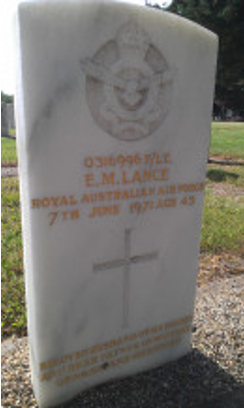 |
Final Rest and Legacy |
But what of his Legacy? |
|
1970 was a watershed year politically speaking, both in the USA and in Australia, the year saw their respective domestic anti-war movements peak, and it was not a minority of ‘Liberal’ snowflakes, the peak saw significant parts of the voter base from all parts of society stand up against their governments. ‘The Peace Moratorium’ campaign in Australia drew over 200,000 Australians protested across the country and approximately 100,000 citizens participated in epicentre march in Melbourne. In the USA – over 2 million American civilians joined their ‘Peace Moratorium’ marches. The writing was on the wall and by August 1971, the Australian Prime Minister, William McMahon, officially announced he would lead a campaign to withdraw all troops from Vietnam. |
|
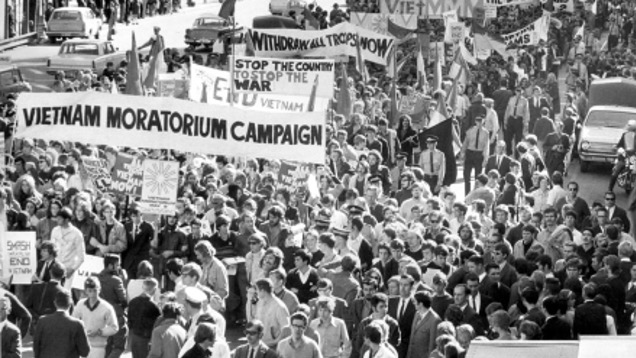 |
|
Vietnam War Peace Moratorium march in Melbourne, Australia 1970 The brutality of the war and the deep social divisions created by it left many with very deep psychological wounds and many refused to talk about – and not just the ‘Free West’ veterans from France, America and Australia, many of the Vietnamese veterans, North and South also found themselves in the same boat – it was all just too painful, better to just forget. As in America, Australia – under its ANZAC values – has in recent times been able to reconcile with its Vietnam War past, especially in understanding the long-term mental effects of the war on its veterans and reinstalling honour to both the veterans and the military personnel who sacrificed their lives when their country called them to duty. Lofty Lance now occupies a special place of honour on the Australian honour roll, remembered annually on ANZAC day. He is not really remembered on honour rolls in South Africa, he does however occupy a special place on the S.A.T.S General Botha remembrance roll (the South African Training Ship’s base that he initially cut his military career on) and a plaque has been dedicated to him by the ‘Botha Boys’ in recognition of his sacrifice along with that of Albert Frisby a fellow pilot killed in Korea. The plaque was dedicated in an official ceremony to the S.A.T.S General Botha cenotaph and full respect to the Botha Boys for doing the excellent work that they do. |
|
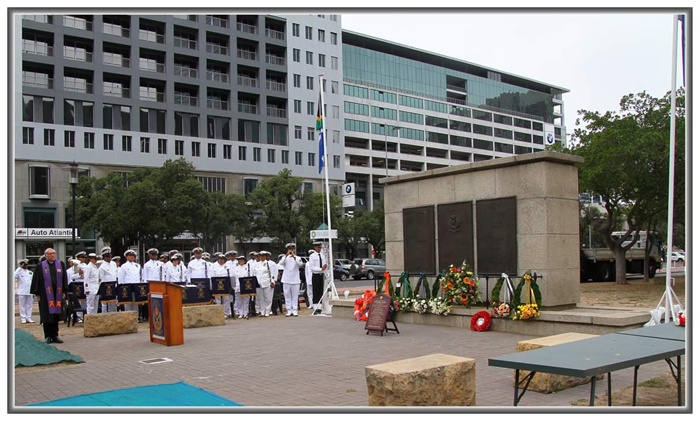 S.A.T.S General Botha (Cadet 1305) Dedication joining the ranks of many ‘Botha Boys’ |
|
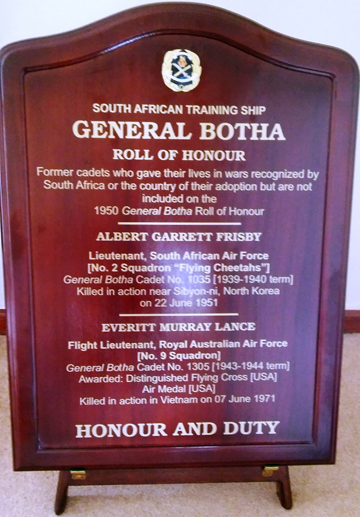 |
However, nationally he is not really acknowledged as a son of our land lost in one the most tumultuous wars experienced after WW2, in fact it’s very likely that this article will be an eye-opener for many South Africans. |
Conclusion |
|
South African military veterans and wars fought prior to 1994 need to be viewed in their historical context, and this includes Lofty Lance. The ‘Cold War’ was a very real one and the jousting between Communism and ‘The Free West’ was a highly deadly one. As the dominoes fell to Communist backed insurgencies in 1966 on the Indo-China sub-continent, so too did dominos fall on the African sub-continent. The same call to arms which brought American and Australian young men into conflict against Communism was used in South Africa to call men to arms, and many did – not to fight ‘for Apartheid’ but to fight against ‘Communism’. Yes, it’s all rather ‘grey’ now and the values which drove these men to fight are not clear to many as history has also shown that this call to action was also overplayed by governments trying to attain futile political goals in a sea of social dissonance and domestic resistance to their policies. The Vietnam War would ultimately prove a pivot in the history of ‘western democracy’ – it literally forced the USA to re-embrace the values of ‘freedom’ on which its founders shaped the American nation, changed American culture at its very core and steered the country into its modern identity – from its music to its civil rights. What is also clear is that serving personnel in the military serve their country against any adversary and the honour to do this is theirs. Men like Lofty Lance made a career of the military, and like many in this career he moved around within his country’s Allies respective armed forces to advance it. Remember that when Lofty served in the SAAF, South Africa was a ‘Union’ and a ‘Dominion’ – Canada, the UK and Australia were all military Allies with South Africa as they were also part of the Commonwealth and all of them took part as partners in WW2 fighting the onset of Fascism and subsequently in the Korean War fighting the onset of International Communism – literally fighting side by side. Given shortages and secondments it was not at all unusual to find South African airmen in Allied Air Forces. |
|
In doing so, the ‘Allies’ and the ‘Commonwealth’ military coalitions would eventually reshape European democracy and turn the efforts of ‘International Communism’ around. They forged the modern democracies we now find ourselves in with all the modern liberties we now enjoy. Lance’s service was one of honour and one so dangerous that few men are drawn to it. It is with the same honour that we should remember one very brave South African – Flight Lieutenant (Lofty) Everitt Murray Lance, may you Rest in Peace, your duty done. |
|
 |
|
In Memorial Australian War Memorial Flt Lt Everitt Murray Lance |
|
Enlistment: RAF London Awards: |
|
Ft. Lt. Everitt Murray Lance RAAF Casualty Database Find A Grave Australia and the Vietnam War RSL Virtual Wall Vietnam War Service The London Gazette South Africa War Graves Project  * Return to 3rd Battalion Roll of Honour |
|
 Cpl. David John Dubber MID 9 Squadron RAAF |
||
| KIA 7th June 1971 | ||
| Australian War Memorial Last Post Ceremony on Sunday the 6th June 2021. |
||
| Downloads Cpl David John Dubber MID Life Story. Event surrounding the death of Flt Lt Everitt Murray Lance and Cpl David John Dubber MID on 7th June 1971. |
||
 Cpl. David John Dubber MID David J. Dubber, 28, Coburg, Victoria.  Cpl. David John Dubber MID A School Project (By Troy, Nerida, Nik & Chanel Jacobsen) David John Dubber was born on the 17th of April 1943 in Coburg, Victoria just outside of Essendon. David attended St. Pauls Catholic High School completing senior schooling and later joined the Royal Australian Air Force in 1967 as a member of the ADG. David was eventually posted to Vietnam twice, the first time being mentioned in dispatches for leadership courage and devotion to duty. On Davids second tour of duty to Vietnam he was killed when his helicopter was shot down during a medevac operation on the 7th June 1971. David was brother to Patricia and Margaret, he left behind a wife and daughter Lisa who was five. An ADG's main job is to make sure that the perimeter of an air base is protected from intrusions. Also part of an ADG's role was to be a door gunner who would use a M60 machine gun and provide covering fire during medivac operations. Dave continued his career with 9 Sqn RAAF where he became a specialist door gunner. On the 7th of June 1971, a battle occurred that is now known as the Battle of Long Khanh, during which B Company 3rd Battalion RAR units were receiving concentrated small arms fire from a fortified bunker system in the northern most portion of Phuc Tuy Province called section AO GOLD. The 3rd Battalion RAR, 5 Platoon were almost out of ammunition and had wounded. A medivac for the wounded was requested along with an urgent ammunition resupply. The situation urgent, Greg Forbes recalls being thrown into the Co-pilot seat and told to pick up some ammo and drop it off to B Company, 3 RAR because they were under heavy enemy attack and low on ammo. The aircraft fell from a height of approximately 120 feet. A tree branch came through the front windscreen, crushing the Captain Flight Lt Everitt Murray Lance and part of the chopper. A Sergeant from 3RAR who had got on board to help unload the ammo fell out of the chopper and survived the fall with serious back injuries. Greg Forbes (co-pilot) received a lacteration to his face requiring eight stitches in his nose and the crewman, Corporal Peter Vidler, had also survived with a broken/dislocated shoulder. Cpl David John Dubber was thrown out of his position on impact with the tree. Albatross 06 then fell pinning him under the helicopter by his legs. David Dubber was trying to free himself from the helicopter wreck when the helicopter exploded and burnt. The crash and subsequent fire was seen to have been the caused his death. Graham Kells, the 23 year old platoon commander of 5 platoon B company 3RAR said he saw the helicopter crash with a full load of ammunition and then it explode. While he never met Dave personally Graham thinks about David and Lofty (Lance) often. David J Dubber was a fit and healthy man. He was survived by his wife, June, and their five year old daughter Lisa. David loved a good party and if he didn't know of a party happening, he would throw one himself. He was also a very talented singer and musician and he would go down to local pubs with his best friends, Jock Massie, John Robson and John Scott, where he would sing in competitions and score a place in the finals. "His best song was 'Oh Danny Boy'. "He could really sing it," John Scott said. He would also sing at the Grand Hotel at Vung Tau to earn some money on the side. David Dubber received the MID for his leadership, courage and devotion to duty. It is said that the night before he died a fortune teller came up to his table at a local restaurant and didn't want to read his fortune as he had a bad feeling. "Whether this was related to what happened the next day or not, I still wonder" John Scott quoted. He also said, "Vietnam was a place where you could make friends and lose them in the blink of an eye..." Cpl David John Dubber MID |
||
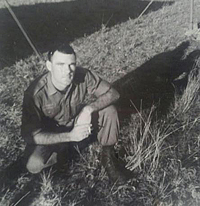 |
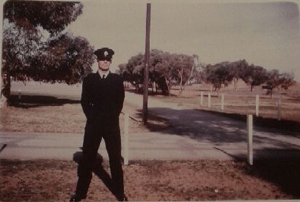 |
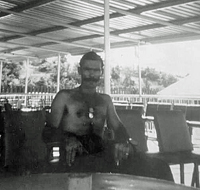 |
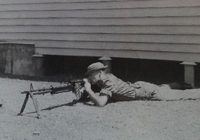 |
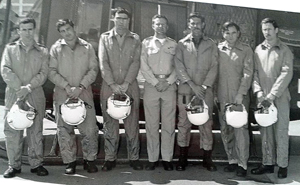 |
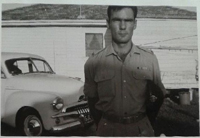 |
See also:
Radschool Association Magazine - Vol 33


Service number: A317809 |
* Return to 3rd Battalion Roll of Honour
![]()
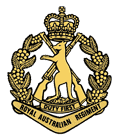
Pte. Lex William Hickson Adams
2nd Battalion Royal Australian Regiment
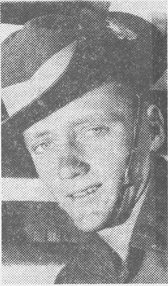
![]()
1 Platoon 2 RAR (Under operational Control by 3 RAR) engaged the enemy in a very large and well fortified bunker system located on the Song Rai. Withdrawing from the contact was difficult however wounded were eventually removed with the assistance of reinforcements who defended the position and assisted in the dust off. Lex Adams was one of 7 wounded in action during this contact. Lex subsequently died of his wounds.
Pte. Lex William Hickson Adams
2nd Battalion RAR
Internet site notes on the dedication of a Coolangatta Memorial.
See:
http://www.nashoqld.org.au/COOLANGATTA_Memorial.html
On Anzac Day, 2006, the School added two more names of past pupils to the Coolangatta Memorial. They are 2nd Lt. John Fraser and Private Lex Adams, both of whom were killed on active service in Vietnam
Private Adams, aged 23, of 2nd Battalion, R.A.R., was killed in action in a Viet Cong tunnel system in Phuoc Tuy province on 31 March, 1971. He and his brother had been fostered by the Norris family.
Pte Lex William Hickson Adams
Australian Newspaper
1986
Lex W. H. Adams, 23, Coolangatta. At the age of three, Lex and his brother John were fostered by the Norris family. An A grade student, he obtained a university degree in optometry before enlisting with friends in 1968. A mortar man and rifleman with 2 RAR, he was killed in action in a bunker system in Phuoc Tuy Province on March 31st, 1971. He left a daughter, Lisa the Norris family and brother John.
See Also: Australia and the Vietnam War
Find a Grave
Service number: 1201945 |
* Return to 3rd Battalion Roll of Honour
![]()

2Lt Ian George Mathers
12 Fd Regt (RAA)
Last Post Ceremony
24th April 2021.
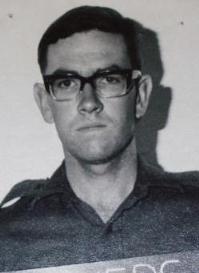
![]()
2Lt Ian Mathers' Story
(2794496 2Lt Ian George Mathers - Royal Australian Artillery)
Biography
Ian George Mathers was born in Brisbane Queensland, on 3rd January 1949 to George and Olive Mathers. His father George, a Scottish immigrant, was at the time a serving member of the Royal Australian Air Force, having enlisted shortly before the outbreak of World War Two.
Ian grew up in the suburb of Corinda, where his sporting interests included rugby union, swimming and squash. He also had a great passion for singing.
Educated at Brisbane Grammar School, Ian's daily journey to and from school took him past St John's Cathedral. At an early age he decided he wanted to join the choir boys in their flowing black and white robes. He made the grade, was good, and in the afternoons, he went straight from school to the cathedral for choir practice. By the time Ian was 14, because of his likeable personality and superb voice, he was head chorister. Then his voice broke and he concentrated on his schoolwork, but he returned to the cathedral often to pray and see his friends.
Ian was a young man by the time he matriculated and gained admission to Sydney University to study economics. Initially residing in St Paul's Residential College, he later moved into a share house in Mitchell Street, Greenwich. Whilst studying, Ian held a cadetship with the Colonial Sugar Refining Company, but whenever time permitted, he would return to Brisbane to see his family and visit the cathedral. A keen rugby union fan, Ian both played the game for the Sydney University Rugby Club and gained his refereeing credentials.
Ian was called up for National Service at age 20, and after a deferment to complete his university studies, he entered the Army in January 1970. He was selected for officer training and successfully completed the gruelling six-months course at the Scheyville Officer Training Unit near Windsor in NSW and was allocated to the Royal Australian Artillery. Amongst his fellow officer cadets, Ian was affectionately known as "007", as his ever-present sunglasses and generally suave demeanour lent themselves to such a complimentary nickname.
Now 2Lt Mathers; Ian underwent a further four months of extensive training as a junior Artillery Officer at the Army School of Artillery at Sydney's North Head. He trained both to command an artillery section and to act as a Forward Observer attached to an Infantry Company. Following this, he undertook Battle Efficiency training at the Army's Jungle Training Centre at Canungra in Queensland.
Ian was granted two weeks leave in early December 1970 and was thus able to enjoy an early Christmas with family and friends. On Christmas Eve 1970, less than 12 months after joining the Army and two weeks shy of his 22nd birthday, 2Lt Mathers landed in South Vietnam to join 12 Field Regiment Royal Australian Artillery.
During the Battle of Long Khahn in June 1971, Mathers was the artillery Forward Observer attached to B Company of the 3rd Battalion Royal Australian Regiment. Early in the morning of June 7, elements of the North Vietnamese Army moved closer to B Company so as to avoid the artillery fire that 2Lt Mathers was bringing down on them. Realising the need to move back, as he attempted to do so Mathers received a gunshot to the chest, killing him instantly.
Back in Australia the newspapers dutifully recorded the death of 2Lt Ian George Mathers - the 401st Australian serviceman, and the 8th National Service Army Officer, to die in that war.
Ian Mathers' funeral was conducted in his beloved St John's Cathedral Brisbane. The local Courier Mail newspaper reported that on the flag-draped lid of his coffin, the present head chorister, a boy of another decade, laid his medallion of office. Mathers' cap and sword, in correct military fashion, were already there.
The sacrifice that 2Lt Ian George Mathers made is commemorated at the Mt Thompson Cemetery in Brisbane and at the AWM. He was 22 years old.
Information above sourced from:
• Article in 'The Courier Mail' newspaper by Chris Black (mid-June 1971).
• 1OTU Scheyville graduation record for Class 1/70 (15th July 1970).
• 'Command in Vietnam' by Col FP Scott (Slouch Hat Publications 2007).
• Service Records of 2Lt Mathers (Series # B2458, Barcode # 9547086).
• Personal interviews with ex-Army colleagues of 2Lt Mathers.
Kindly supplied by Bill Moss
2Lt Ian George Mathers
Australian Newspaper
1986
Ian George Mathers, 22, Brisbane, Queensland.
Conscript economic student, graduated as a second Lieutenant from the quickie officers course at Scheyville, NSW on July 16 1970 after call up six months earlier. Posted to Vietnam with the RAA, he was one of three Australians including two from the RAAF, who were killed in action during an enemy contact in Long Khanh on June 7, 1971. Fourteen men were also wounded in the same battle.
Australian War Memorial
Unit History
"A" Battery, Royal Australian Artillery
With its origins stretching back to the colonial period, A Field Battery is the oldest serving unit in the Australian Regular Army. Despite its long and distinguished history, A Field Battery did not participate in the Vietnam War until the final year of Australia’s commitment to the conflict.
After serving in Malaysia the battery returned to Australia in 1967, joining the 19th Composite Regiment at Holsworthy. In 1969 the 19th Composite Regiment became the 12th Field Regiment, consisting of the 104th Field Battery and A Field Battery. Having spent 12 months in north Queensland undergoing pre-operational training, A Field Battery arrived at Nui Dat in late January 1971. The arrival of the 104th Field Battery in Vietnam in May 1971 reconstituted the 12th Field Regiment, and this organisational arrangement persisted for the rest of A Field Battery’s tour of duty.
In February 1971 A Field Battery assumed the role of general support for the Australian Task Force. At the time the battery was awaiting the arrival of the 3rd Battalion, Royal Australian Regiment (3RAR), which had been designated as its affiliated battalion. On 2 March 1971 both 3RAR and A Field Battery saw action for the first time, when D Company, 3RAR, became involved in a night-long contact with a company-strength enemy unit known as Chan Duc. In this engagement a section of A Field Battery fired illuminating shells from Fire Support Base (FSB) Marj, while the remainder of the battery fired high-explosive shells from Nui Dat.
In March 1971 the battery supported 3RAR during two encounters with D445, the local Viet Cong battalion. In the first of these encounters a New Zealand artillery unit joined A Field Battery at FSB Beth, thus forming an ANZAC battery.
In April 1971 battery headquarters and the section that had been at FSB Marj moved north to FSB Ziggy, in order to cooperate more closely with 3RAR. The other section of A Field Battery occupied FSBs Jane and Lindy in support of 2RAR, before being relieved at Lindy by the 104th Field Battery.
A Field Battery deployed to FSB Pamela on 5 June 1971 as part of Operation Overlord. On the following day, 3RAR was engaged in heavy fighting with a North Vietnamese regiment. When forward observer Second Lieutenant Ian Mathers, from A Field Battery, was killed during the fighting on June 7, his assistant, Lance Bombardier “Blue” Maher, directed battery fire for nine hours, sometimes to within 100 metres of the Australian infantry. Maher was awarded the Military Medal for his part in the engagement, in the course of which the A Field Battery fired 1,100 rounds.
On 1 August 1971 A Field Battery celebrated its centenary. Some members of the battery flew to Sydney to take part in a ceremonial parade at Victoria Barracks, where a crowd of 5,000 spectators watched the battery’s 67-year-old King’s Banner replaced by a new Queen’s Banner. In Vietnam three of the battery’s guns were at FSB Lynette and the other three were at Nui Dat, where a ten-gun salute was fired at midday. A total of 50 rounds were fired at various locations in Australia and Vietnam to mark the occasion. At Nui Dat there was also a church service and an official lunch. Afterwards there was a party, at which the officers and senior NCOs served a meal to the men.
In late 1971 Australia’s commitment to the Vietnam War was being scaled down. In August and September of that year A Battery closed down several FSBs as part of a wider cessation of operational activity. In October the battery moved from Nui Dat to seaside Vung Tau, departing for Australia on 6 November 1971 aboard HMAS Sydney.
Service number: 2794496 |
 |
| The 3 RAR Internet site gratefully acknowledges the assistance of 101 design of Wollongong. www.101design.com.au |
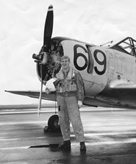
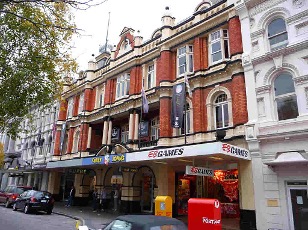
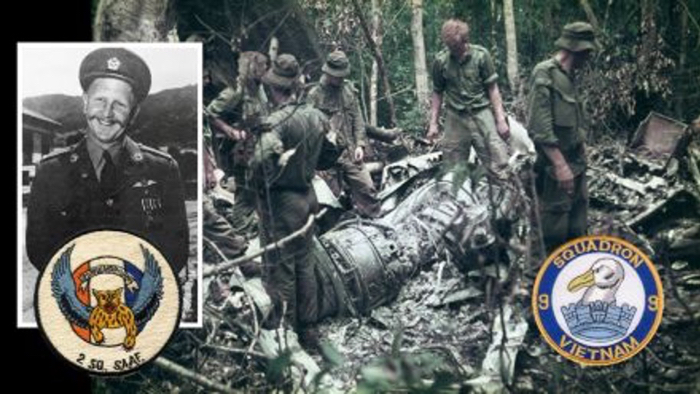
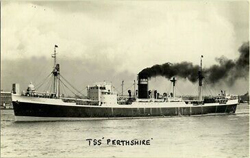
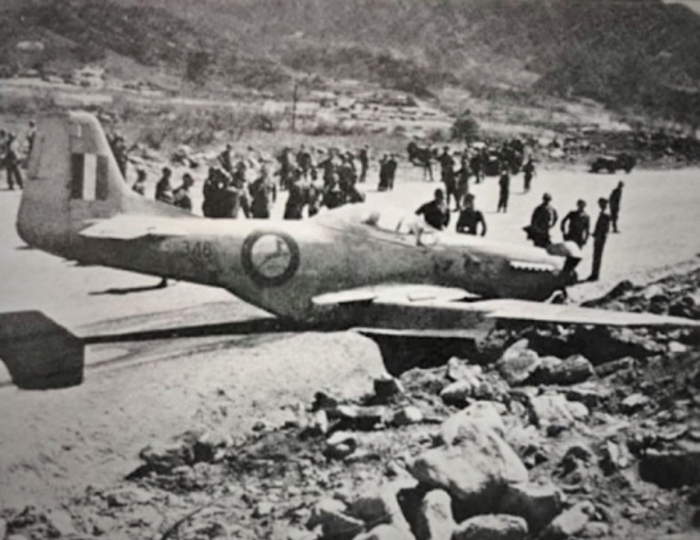
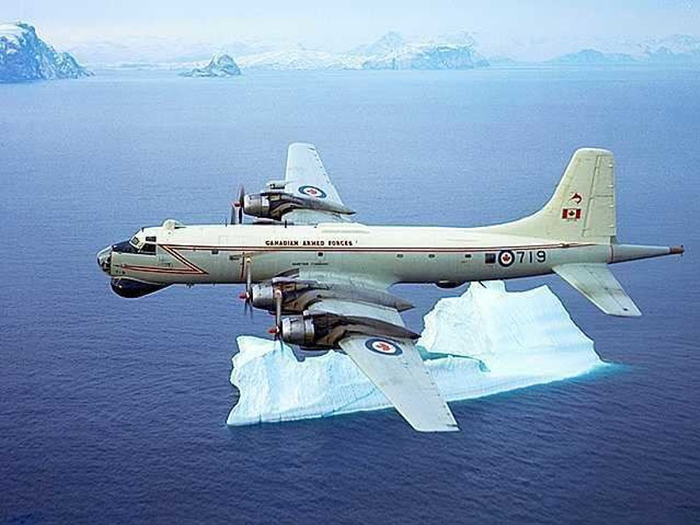
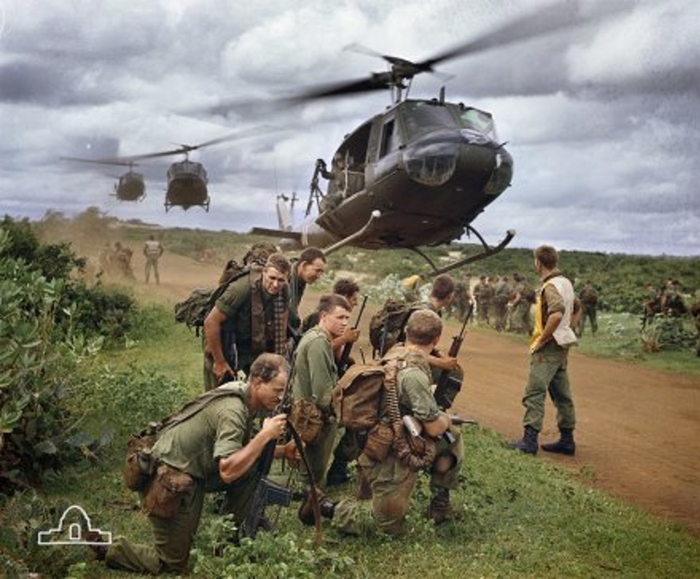
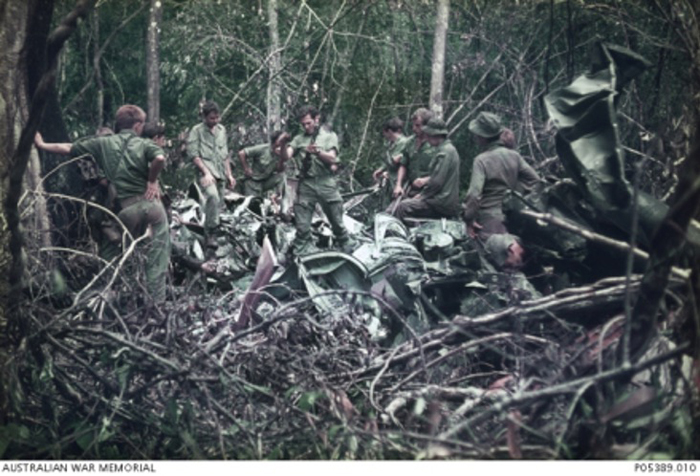
 Commonwealth aircraft identification roundels for each air force in Lofty Lance served.
Commonwealth aircraft identification roundels for each air force in Lofty Lance served.